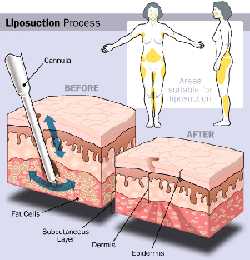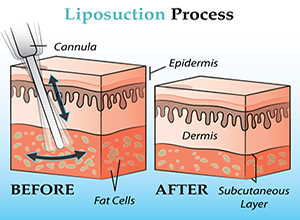
Liposuction
What is liposuction?
Liposuction, also referred to as lipoplasty or suction-assisted lipectomy, is a surgical procedure that recontours the body by removing excess fat from specific areas, including the abdomen, hips, thighs, buttocks, upper arms, chin, and neck. by the use of especially designed metal cannulas and suction machine.


Am I a good candidate for liposuction?
The best candidates for liposuction are normal-weight people who have localized fat disease that do not respond well to diet or exercise . Liposuction can be done at any age, but those with firm, elastic skin achieve the best results since elasticity lends itself to smoother contouring after the fat removal. Large volume of fat removal will also help reduce weight of the person.
What technique will the surgeon use to perform the liposuction?
Tumescent liposuction is the one basic technique used in all patients undergoing liposuction surgery. This technique involves the infiltration of wetting solution followed by insertion of a metal cannula, through a tiny incision into the layers of fat that lie deep beneath the skin . The cannula is connected to a suction device that literally vacuums the fat out as the surgeon breaks up the cells with a push/pullmotion.


What is "wetting solution"? Why do we use it.
Wetting solution is the delivery of subcutaneous infiltration into the subcutaneous fat before the use of liposuction. It has two advantages: an anaesthetic effect secondary to the use of lidocaine and a haemostatic effect due to use of epinephrine.
If the fat is removed, will it return?
The body produces fat cells during three different periods: in utero, early childhood and early adolescence. In general, after reaching maturity the total number of fat cells in the body will not increase. Fat cells that are removed through liposuction or other techniques will not be replaced by other fat cells. So the resultant loss of fat & weight loss cells will be permanent.


How much fat can be removed?
Whatever extra subcutaneous fat is there can be removed in a single sitting from different parts of body .
How long is the recovery period?
The recovery period usually lasts from 3 weeks to 3 month for the final shape of that body part but the result of liposuction is visible immediately after surgery , depending on the patient and the extent of the procedure . Usually patients can return to work from the next day of surgery more strenuous physical activity after two to four weeks.
What is the postoperative care required?
No special care is required but one has to wear pressure garments for at least 3-6 months.
Does the excessive skin need to be resected after removal of fat by liposuction?
In general, despite large amounts of fat being removed, skin has good elasticity and will reconfirm to the new underlying volume with the help of pressure garment. However, in patients with inelastic skin or in older patients skin resection like Abdominoplasty or tummy tuck operation may be needed along with SAL.
Are the results of liposuction permanent?
The results of liposuction are usually permanent with a sensible diet and exercise. If the patient gains weight post-liposuction, the fat is usually distributed to other areas of the body.
What are the risks associated with liposuction surgery?
The most common sequelae include contour irregularities, paraesthesias, oedema, ecchymosis & discoloration, which occur routinely in almost all patients who undergo liposuction. However, they resolve spontaneously or with minimal treatment such as massage & Pressure garment.
How much does liposuction surgery cost?
The cost of a liposuction procedure depends on a number of factors including the surgeon, the geographic region, and the size and number of body areas targeted.

Before

After

Before
After

Before
After

Before

After

Before

After

Before
After

Before





